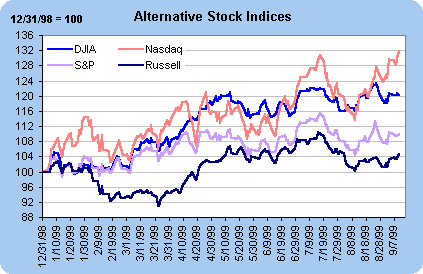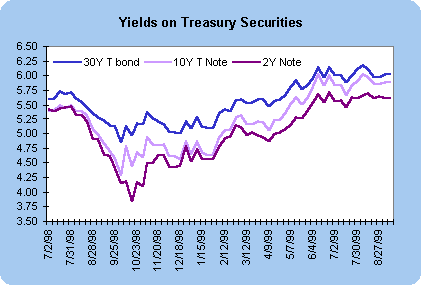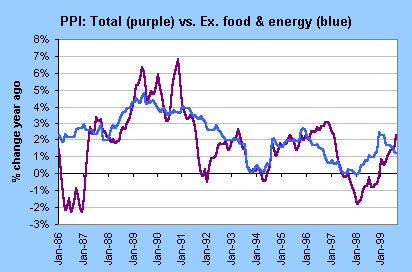
|
Today's Calendar |
| | Simply Economics |
| | International Perspective |
| | Resource Center |
 |
|
| 1999 Articles |
|
By Evelina M. Tainer Chief Economist, Econoday Week ends on friendly inflation news, but Dow falls short
Light week keeps markets on track  The S&P 500 as well as the Russell 2000 continue to underperform the other two measures. The S&P 500 has stabilized in a narrow range recently. The Russell 2000 index of small cap stocks has recovered slightly from early August, but continues to be the weakest of the group.
Bond markets try to anticipate the Fed 
PPI: worse and better than expected Excluding food and energy prices, the PPI edged down 0.1 percent, following the downward trend of the past several months. The so-called core PPI is now 1.3 percent above year ago levels. Yet, as the chart below indicates, the core component is slowing down, not accelerating its rate of growth. While it is important not to downplay the negative impact of higher energy prices, one should keep in mind that price hikes in one sector merely changes the structure of relative prices. It doesn't cause inflation to spurt on an economy-wide scale.  As market players have become more sophisticated, they now turn to the PPI at earlier stages of processing. The PPI for intermediate goods increased 0.8 percent while the PPI for crude materials jumped 4.6 percent. Again this was due to spiraling energy costs. Excluding food and energy, the intermediate goods index increased 0.2 percent. Yet, the crude materials index rose 1.8 percent. The crude materials index is more closely aligned with commodity prices -- such as the daily CRB index. Conventional wisdom indicates that price increases at earlier stages of processing will eventually filter through to the PPI for finished goods (and then the consumer price index). Our research has shown that in fact, price gains in crude materials and intermediate goods are not always passed along. In competitive environments, when general inflation trends are low, they tend to become higher costs to producers that result in lower profit margins. The bottom line on the PPI? The inflation news was generally favorable as the core PPI component continues to slow its rate of growth. Prices rose more dramatically at earlier stages of processing, but these price hikes are not always passed on to consumers. It could result in lower profit margins for producers, instead, as they try to maintain market share in competitive environments.
Import/export prices....it's oil again  The bottom line on import/export prices? While energy prices are clearly the culprit in the higher price scenario in the chart above, it is also useful to note that the trough in import prices is probably behind us. Inflation may not be in a rapidly accelerating mode, but we have seen the best inflation news already.
THE BOTTOM LINE The inflation news was generally favorable. It does appear that price hikes are generally limited to the energy sector. This week's data did not give financial market players any clue as to whether the Fed will raise rates or not at the next FOMC meeting in early October. Market players will have to wait and see as economic indicators are reported in coming weeks.
Looking Ahead: Week of September 13 to 17
Tuesday
Wednesday Business inventories are expected to rise 0.5 percent in July, the same as in June. This incorporates the data already available for wholesale trade and manufacturing inventories.
Thursday The consensus forecast shows that industrial production will edge down 0.1 in August after a healthy 0.7 percent gain last month. This incorporates the sharp drop in factory payrolls reported last week. At the same time, the capacity utilization rate should decline to 80.4 percent from 80.7 percent in July. The Philadelphia Fed's business outlook survey is expected to edge lower to 11.5 in September from the August level of 12. This series tends to mirror changes in industrial production with a one-month lead.
Friday |
|||||||||||||||||||||||||||||||||||||||||||||||||||||||||||||||||||||||||||||||||||||||||||